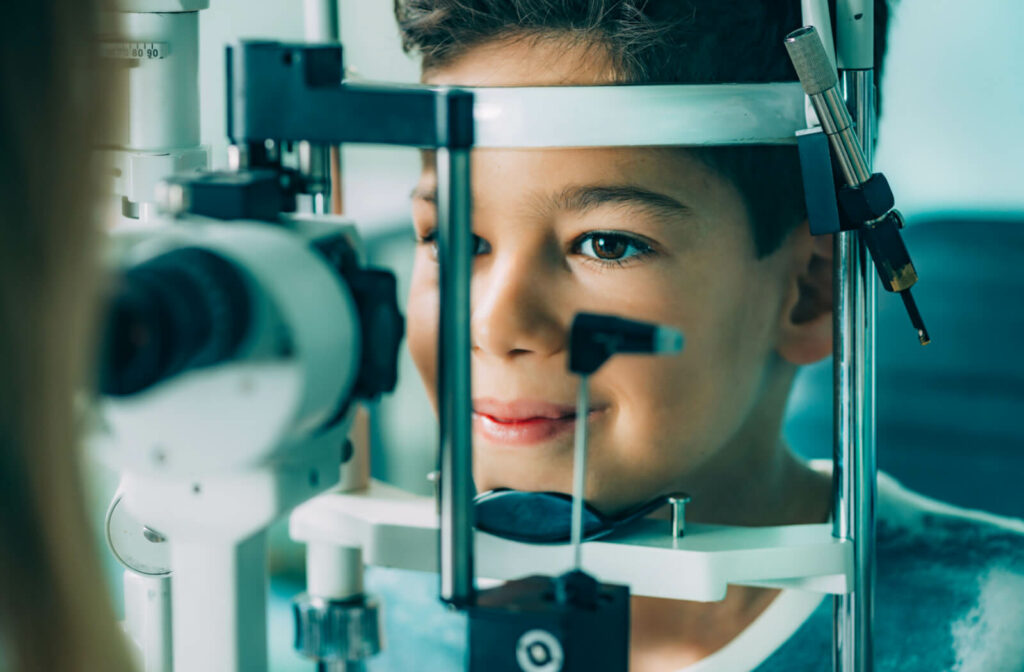Myopia is a common refractive error that often develops early in a child’s life. Unfortunately, there isn’t always a way to completely prevent myopia due to the genetic factor in its development, but there are strategies you can employ to help reduce your child’s risk of developing myopia.
Taking breaks from screen time, getting adequate sunlight exposure, and getting regular comprehensive eye exams may all help reduce your child’s risk of developing myopia or experiencing severe myopia progression. In some cases, myopia control can also help prevent further myopia progression for children who are already affected by nearsightedness.
The bonus is that these tips aren’t solely for myopia prevention. They can also benefit your child’s eyes and vision in other ways—from helping prevent dry eye to preventing more serious eye conditions, like age-related macular degeneration and cataracts.
What Is Myopia?
Myopia, commonly known as nearsightedness, is a refractive error that can affect your ability to see distant objects clearly. People with myopia can typically see objects up close but struggle to see things clearly at a distance.
Myopia occurs when the eyeball is too long or the cornea (the clear front surface of the eye) is too curved, causing light to focus in front of the retina instead of directly on it. It often first develops during childhood and tends to stabilize during early adulthood.
Causes of Myopia
Several factors can contribute to the development of myopia, but genetics play a key role in myopia development. If one or both of your parents have myopia, you may be more likely to develop it as well.
Other factors that can increase a person’s risk of developing myopia include spending too much time on close-up work, such as reading, writing, or working on a computer screen. Environmental factors, such as lack of adequate time outdoors, may also contribute to myopia development.
Symptoms of Myopia
One of the most common symptoms of myopia is when your vision is blurry and you struggle to see things that are far away from you, but other symptoms include:
- Squinting
- Eye strain
- Headaches
- Tired eyes
Child-specific signs of myopia may include:
- Poor performance at school
- Short attention spans (myopia can sometimes be misdiagnosed as ADHD because of the overlap in symptoms)
- Holding things close to their face or needing to sit close to the front of the class
- Sitting too close to the TV
- Poor depth perception or hand-eye coordination
What Can Prevent Myopia?
There isn’t a guaranteed way to prevent myopia because there is a genetic component that cannot be avoided. But there are strategies you can use to lower your child’s risk of developing myopia.
Take Breaks from Screen Time
Screen time is a natural and essential part of many children’s lives—whether it’s necessary for school or they’re playing a game on their tablet. However, there does appear to be a link between prolonged exposure to screens and risk of myopia development during childhood.
Research is continuing in this area, as results are mixed in some studies. But, limiting screen time can be essential for other reasons too—it can help prevent other uncomfortable conditions, like dry eye syndrome and digital eye strain.
Get Enough Sunlight
Studies have shown that spending more time outdoors, especially during childhood, may reduce the risk of myopia development. Research suggests that 10 hours weekly spent with outdoor light exposure can lower a child’s risk of developing myopia by over 60%.
This is thought to be because bright, natural light stimulates the release of dopamine, a chemical that helps prevent eye elongation, which is a common cause of myopia. So, it’s a good idea to encourage your child to spend time outdoors.

Regular Eye Exams & Myopia Control
While regular eye exams don’t necessarily prevent myopia or any other eye conditions, they can certainly be instrumental in the earlier detection of refractive errors, which can result in more successful treatment.
Routine eye examinations, as recommended by your child’s optometrist, can help identify any changes in your child’s vision and determine whether or not they need corrective lenses—or if they’re at risk of developing myopia.
Your routine eye exams are also a great opportunity to explore your child’s options for myopia control. Starting myopia control early in life can help kids reduce their lifetime progression of myopia, preserve their vision, and reduce their risk of developing other serious eye conditions later in life.
Discuss Myopia Prevention & Treatment with Your Eye Doctor
Even if myopia can’t be prevented, there are things you and your child can do to reduce their risk—and slow myopia down when it does develop. Contact us at Total Vision Pasadena today. Our team is happy to discuss your child’s eye health and help protect their vision.




